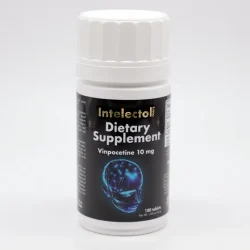Vinpocetine (Intelectol®) is a synthetic alkaloid derived from the periwinkle plant (specifically, synthesized from the molecule known as ‘vincamine’) that appears to have a track record of usage in European countries for the treatment of cognitive decline, stroke recovery, and epilepsy. Vinpocetine is also commonly used as a nootropic compound in the hopes that it may promote memory formation.
Vinpocetine (Intelectol®) is not fully absorbed, but what is absorbed peaks in the blood rapidly and easily enters the brain where it can exert its functions. The properties that appear to apply to oral vinpocetine supplementation include neuroprotection (against toxins and excess stimulation) and reducing neural inflammation, whereas the cognitive enhancement effect does not appear to be well supported by evidence at this point in time. While vinpocetine does appear to be effective in preventing toxins or stressors from causing amnesia, it is not yet demonstrated to inherently improve memory formation.
Vinpocetine also appears to have some efficacy against cognitive decline, but the amount of literature on this topic is much less than other drugs tested for this purpose (CDP-Choline or Alpha-GPC in particular). At least one study has noted an improvement in reaction time with a 40mg tablet of vinpocetine, which may be one of the only practically relevant improvements for healthy persons at this moment in time.
Infusions of vinpocetine do appear to enhance blood flow to the brain without inherently modifying pressure systemically, and this is thought (but not shown) to apply to oral ingestion. This would potentially reduce headaches caused by excessive pressure, and is in accordance with the traditional usage of the periwinkle plant (to reduce headaches).
Vinpocetine appears to have a role in neuroprotection and reducing neural inflammation, and for healthy persons it may potentially increase blood flow to the brain and improve reaction time (Limited evidence all around). The benefit of vinpocetine in memory formation is not yet proven, but it may protect the brain from amnesia.
It appears to interact with several ion channels (sodium, potassium, and calcium) while tends to result in suppressive effects on neurotransmitter release and neuroprotection when dopamine or glutamate are suppressed (these two, when unnecessarily stimulated by toxins, can cause oxidative damage). It also interacts with alpha adrenergic receptors and the TPSO receptor, and while the exact benefit of these receptor interactions are not clear they are probably relevant since they occur at the same concentrations that the ion channel interactions do.
Vinpocetine is also a PDE1 inhibitor, which is a mechanism that is both cardioprotective and cognitive enhancing. Unfortunately, this inhibition occurs at a fairly large dose and may not apply to standard supplemental dosages of vinpocetine.
Similar to PDE1, an antidopaminergic potential of vinpocetine and direct inhibition of glutaminergic receptors both appear to occur at very high concentrations in vitro and may not be relevant to standard supplementation.
Vinpocetine is likely a modulator of ion channel activity, although there are some receptor interactions on alpha-adrenergic and TSPO that appear to be relevant. Other mechanisms including PDE1 inhibition or hindering glutaminergic/dopaminergic neurotransmission have been noted in vitro but at concentrations which are much higher and thus may not be relevant following oral ingestion of vinpocetine.
- Vinpocetine has been linked to fetal toxicity in a series of animal studies.
- Caution in warranted.

